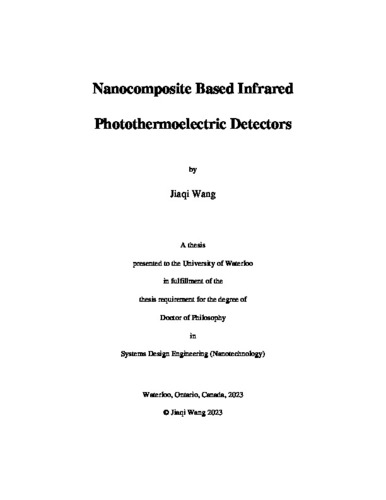| dc.description.abstract | In the last decade, photothermoelectric (PTE) detectors that combine photothermal and thermoelectric conversion have been demonstrated for infrared and terahertz tracking. They are advantageous in terms of facile fabrication, simple structures, room-temperature operation and self-powering capability. However, some challenges remain to be addressed, including low response performance, large-area fabrication and quick degradation. Based on the aforementioned challenges, this thesis targets optimizing current detectors and exploring new detector structures, which eventually enhance the PTE response and create possibilities for scalable manufacturing and mass production.
In this thesis, we mainly develop four innovative PTE detectors. Firstly, we propose a new PTE structure using a capillary-assisted carbon nanotube forest (CNTF). By creating different CNT growth conditions, two regions of CNTF are grown and connected by the introduction of dimethyl sulfoxide. The detectors show a quick and sensitive infrared response. Secondly, we propose flexible and Si-based PTE detectors using CNT/poly(3,4-ethylenedioxythiophene) polystyrene sulfonate (PEDOT:PSS) composite. Both detectors show quick mid-infrared responses and demonstrate non-destructive imaging tracking capacities. Thirdly, we create a vertical PTE detector using MXene/PEDOT:PSS composite and integrate the metamaterials into PTE detectors. The applications of non-contact fingertip tracking are achieved. Finally, the PTE detectors using CNTF active layer with MXene electrodes are fabricated and packed with PTFE, which enhances the stability and also indicates the non-destructive testing capacities.
Overall, this thesis proposes a systematic method of designing infrared PTE detectors mainly based on CNTs, MXene and related composites, which also provides guidelines and methodology for developing other low-dimensional material/composite based PTE detectors. Furthermore, these detectors also pave the way toward wearable smart sensors for industrial applications. | en |

